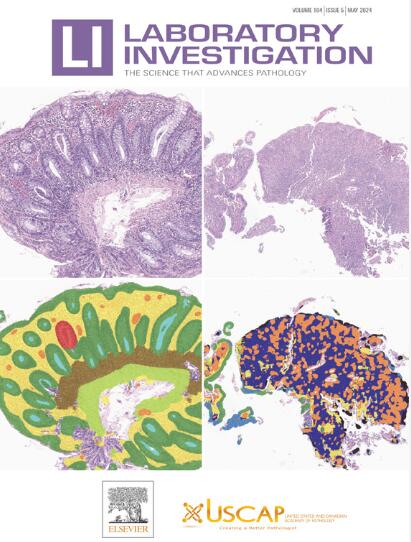肿瘤细胞与神经间的egr1 - bdnf连接串扰在涎腺管癌的神经周围浸润:涎腺管癌新生与前多形性腺瘤的比较
IF 5.1
2区 医学
Q1 MEDICINE, RESEARCH & EXPERIMENTAL
引用次数: 0
摘要
涎腺管癌(SDC)主要分为新生(SDCDN)或前多形性腺瘤(SDCXPA)。HMGA2和PLAG1融合基因在SDCXPA中的发生率高于SDCDN。由于新的治疗策略指导有限,手术切除仍然是主要的干预措施。然而,频繁的复发和转移的管理挑战突出了创新治疗的必要性。本研究旨在探讨SDC的特征,包括围神经侵犯(PNI),并阐明其致癌机制和不良预后因素。我们分析了2014年至2023年在国家癌症中心医院诊断的52例SDC患者。为了比较基因表达谱,我们对30例患者进行了免疫组织化学染色,包括Her2、肾上腺素能受体、PLAG1和HMGA2,然后进行了人表皮生长因子受体2 (Her2)原位杂交和RNA测序。差异分析鉴定基因进行免疫组织化学染色和统计分析。根据PLAG1和HMGA2的组织学分类,52例患者分为SDCDN 26例(50%)和SDCXPA 26例(50%)。与SDCXPA相比,SDCDN表现出更高的神经周围、静脉和淋巴浸润率(P分别为0.0005、0.0294和0.0044)。基因表达谱揭示了这些亚型之间的聚类趋势。以PNI为例,浸润神经周围组织的肿瘤部位早期生长反应1中基因表达降低,呈负相关(P <;。)。此外,RNA测序显示3个新的融合基因。综上所述,SDCDN和SDCXPA在分子和病理特征上存在临床差异。我们发现了SDC PNI患者癌细胞和神经之间的早期生长反应-脑源性神经营养因子连接串扰,为未来治疗和预后因素提供了见解。本文章由计算机程序翻译,如有差异,请以英文原文为准。
EGR1–BDNF–Linking Crosstalk Between Cancer Cells and Nerves for Perineural Invasion in Salivary Duct Carcinoma: Comparison of Salivary Duct Carcinoma De Novo and Ex Pleomorphic Adenoma
Salivary duct carcinoma (SDC) is primarily categorized as de novo (SDCDN) or ex pleomorphic adenoma (SDCXPA). The incidence of HMGA2 and PLAG1 fusion genes has been suggested to be higher in SDCXPA than in SDCDN. Surgical resection remains the main intervention due to limited guidance on new treatment strategies. However, frequent recurrence and challenging management of metastasis highlight the necessity for innovative treatments. This study aimed to investigate SDC characteristics, including perineural invasion (PNI), and elucidate its carcinogenic mechanisms and adverse prognostic factors. We analyzed 52 patients with SDC diagnosed in the National Cancer Center Hospital from 2014 to 2023. To compare gene expression profiles, we performed immunohistochemical staining, including Her2, adrenergic receptor, PLAG1, and HMGA2, followed by human epidermal growth factor receptor 2 (HER2) in situ hybridization and RNA sequencing of 30 cases. Differential analysis identified genes subjected to immunohistochemical staining and statistical analysis. Based on histologic classification using PLAG1 and HMGA2, 52 cases were classified as 26 cases (50%) SDCDN and 26 cases (50%) SDCXPA. Compared with SDCXPA, SDCDN showed higher perineural, venous, and lymphatic invasion rates (P = .0005, .0294, and .0044, respectively). Genetic expression profiling revealed clustering tendencies between these subtypes. Focusing on PNI, gene expression was decreased in early growth response 1 in tumor portions infiltrating perineural tissues, indicating a negative correlation (P < .0001). Additionally, RNA sequencing showed 3 new fusion genes. In conclusion, clinical disparities between SDCDN and SDCXPA based on molecular and pathological features were observed. We found early growth response 1-brain-derived neurotrophic factor–linking crosstalk between cancer cells and nerves for PNI in SDC, offering insights into future treatment and prognostic factors.
求助全文
通过发布文献求助,成功后即可免费获取论文全文。
去求助
来源期刊

Laboratory Investigation
医学-病理学
CiteScore
8.30
自引率
0.00%
发文量
125
审稿时长
2 months
期刊介绍:
Laboratory Investigation is an international journal owned by the United States and Canadian Academy of Pathology. Laboratory Investigation offers prompt publication of high-quality original research in all biomedical disciplines relating to the understanding of human disease and the application of new methods to the diagnosis of disease. Both human and experimental studies are welcome.
 求助内容:
求助内容: 应助结果提醒方式:
应助结果提醒方式:


